Types Of Agents in Artificial Intelligence
Artificial intelligence (AI) agents refer to a broad category of intelligent beings that can understand their surroundings, make choices, and conduct actions to accomplish particular objectives. From autonomous robotics to intelligent virtual assistants, these agents are crucial to many AI applications. This article examines the various AI agent types and their traits, capabilities, and practical uses.
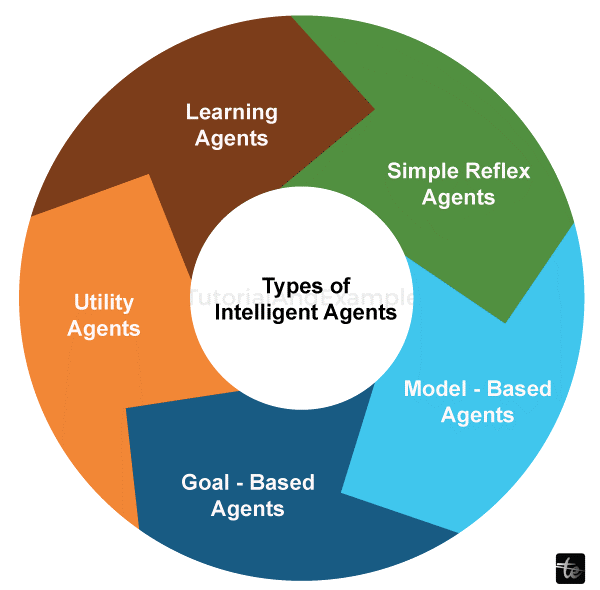
There are mainly five types of AI agents, which are explained below:
1. Simple Reflex Agents
The most fundamental kind of AI bots is those with simple reflexes. They function according to an "if-then" or condition-action rule. These agents observe the current condition of the environment and operate purely in the present, without taking into account the past or potential future effects. Simple reflex agents are frequently utilized in systems that demand instantaneous responses, such as traffic signal controls or thermostat systems.
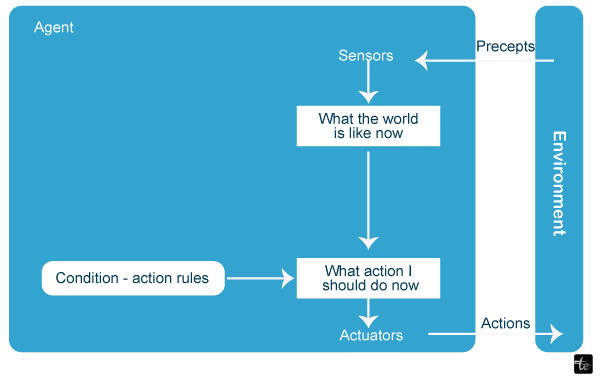
The simple reflex agents are frequently used in systems that demand quick responses based on the information at hand. These agents conduct actions only based on observed input and follow a condition-action rule, also known as an "if-then" method. They perceive the present state of the environment.
Simple Reflex Agents' Characteristics:
Simple reflex agents can perceive the world by using input devices or sensors. These perceptions serve as the foundation for decision-making and indicate the situation of the environment right now.
- Simple reflex agents behave by a set of condition-action rules. Each rule provides a prerequisite that must be satisfied before the related action is done. These regulations are predetermined and do not take the past or the state of the environment into account.
- Simple reflex agents have limited memory capacity and are unable to retain memories of past events or situations. They don't keep an internal representation of the surroundings and just take into account the current perception.
- Simple reflex agents are susceptible to errors due to incomplete information if the present perception does not supply enough details to satisfy the rules' requirements. They are unable to deduce missing information from their surroundings or use logic.
- Simple reflex agents cannot learn, which prevents them from enhancing their performance over time or adjusting to novel circumstances. Their actions continue to be preset and fixed.
Simple Reflex Agents in the Real World:
Despite their shortcomings, basic reflex agents are useful in certain cases that call for quick decisions depending on the condition of the environment. Several instances include:
- Thermostat Systems: These systems use straightforward reflex agents to measure the ambient temperature and operate cooling or heating mechanisms by pre-established rules.
- Traffic Signal Controllers: Simple reflex agents can manage traffic lights based on the flow of current traffic, varying the timing of the signals in response to the presence or absence of moving vehicles.
- Industrial Automation: In industrial settings, simple reflex agents are used to conduct fundamental control functions, such as turning on or off machinery based on sensor inputs.
So, we can say, basic reflex agents are the building blocks of AI systems since they respond instantly to the perception at hand and specified rules. Despite their limitations, they are useful in applications that call for quick decisions without considering past or future circumstances. More complex agent types with learning and adaptive capabilities have arisen as AI technology develops, addressing the drawbacks of straightforward reflex agents and enabling more intelligent and adaptable systems.
2. Model-Based- Reflex Agents
In a conventional reflex agent, choices are made simply based on the current perception, without taking into account the past or potential future effects. A model-based agent, on the other hand, keeps an internal model of the environment up to date to simulate future states and results, enabling more informed decision-making.
The advantages of reflex and model-based agents are combined in a model-based reflex agent, which can be thought of as a hybrid strategy. This kind of agent responds quickly to the current percept while maintaining an internal model of the surroundings.
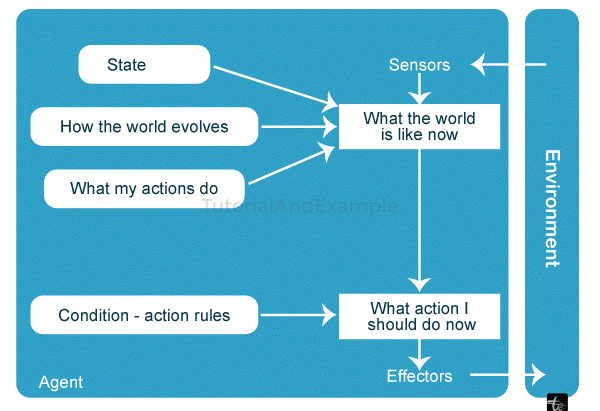
Model-Based Reflex Agents' Characteristics:
Model-based reflex agents pick up perceptions from their surroundings that depict the current environment:
- Internal Model: These agents keep a mental representation of the dynamics of their surroundings, including potential states, actions, and transitions. The effects of actions are simulated using this model.
- Reflexive behaviours: Without deliberate thought or taking the internal model into account, model-based reflex agents incorporate reflexive behaviors that are prompted by the immediate percept. These reflex actions enable prompt reactions to urgent situations.
Benefits of Model-based Agents
Model-based reflex agents can simulate the effects of actions and make decisions based on predicted outcomes by keeping an internal model. Compared to simple reflex agents, this permits more informed and possibly better decision-making.
- Flexibility in Dynamic Environments: Model-based reflex agents can use their internal model to adapt to changes in the environment. They are more flexible in dynamic contexts because they can react fast to present perceptions while also taking into account potential future conditions.
- Trade-off Between Speed and Deliberation: Model-based reflex agents balance model-based decision-making for more deliberate behaviors with reflexive actions for quick replies. This enables them to manage time-sensitive issues while taking into account any long-term effects of their decisions.
Model-Based Reflex Agents in the Real World:
Model-based reflex agents can be used in a variety of fields where quick reflexes and deliberate decision-making are necessary. Several potential uses include:
- Model-based reflex agents can be utilized in autonomous vehicles, which require quick responses to unforeseen circumstances (such as unanticipated obstructions). The internal model can assist in anticipating potential dangers and guiding appropriate responses.
- Model-based reflex agents can help with emergency response systems, including disaster management or firefighting. Using the internal model to optimize activities based on expected results, they can react rapidly to urgent events.
- For jobs requiring quick responses and planning, model-based reflex agents can be used in robotic systems. Robots can respond quickly to immediate perceptions while using internal models to optimize actions based on expected future states and goals.
Even though "model-based reflex agents" is not a phrase that is frequently used, the idea of an agent combining reflexive behavior with an internal model can be advantageous for decision-making and adaptation. Model-based reflex agents may manage dynamic settings more successfully and make wise decisions by finding a balance between reflexes and deliberate actions. Their range of prospective uses includes robots, autonomous driving, and emergency response.
3. Goal-based Agents
Goal-based agents are created to accomplish particular goals or objectives. They have a decision-making component that generates a series of activities to accomplish the objective as well as a goal formulation component that determines the intended outcome. These agents may make use of planning techniques or search algorithms to investigate many avenues and decide which course of action is best. Goal-based agents are frequently used in problem-solving situations like route planning, scheduling, and optimization.
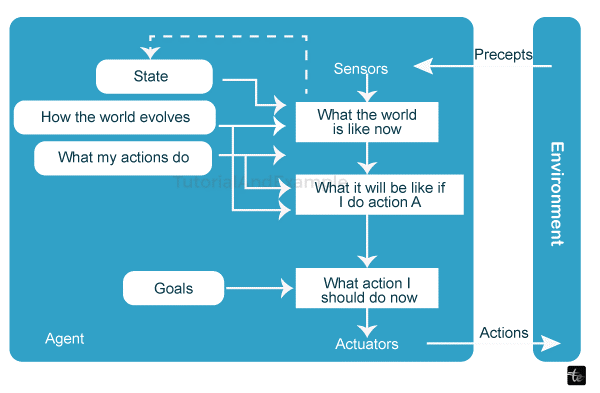
Characteristics of Agents with Goals:
- Goal Formulation: Agents with a goal have a way to create objectives or intended results. These objectives may be predetermined or dynamically determined based on the agent's aims or outside directives.
- Goal-based agents see their surroundings by using sensors or input devices to gather data. They evaluate the status of the environment right now and decide what has to be done to accomplish the objective using this perceptual knowledge.
- Goal-based agents make decisions to produce a series of activities that result in goal achievement. This procedure entails analyzing the existing situation, assessing potential courses of action, and choosing the best course of action by predetermined standards or an optimization plan.
- Goal-based agents frequently use planning algorithms to develop a series of behaviors that may result in goal achievement. These plans specify the actions or subgoals that must be accomplished to reach the main objective. The agent then carries out these steps in an orderly fashion to move closer to the goal.
Benefits of Goal-Based Agents:
- Agents with goals offer a methodical way to tackle issues. These agents may deconstruct complex issues into manageable steps by defining goals and making plans for activities, which facilitates effective goal achievement.
- Goal-based agents are capable of adapting to changes in their surroundings or the requirements of their goals. Based on fresh information or changing priorities, they can dynamically update their objectives or change their action plans.
- Goal-based agents can evaluate trade-offs and tailor their activities by predetermined standards or preferences. They can weigh several options and decide on courses of action that will maximize desired results or cut costs.
Applications of Goal-Based Agents in the Real-World:
Goal-based agents are used in a variety of fields where specified goals must be met. Several instances include:
- Navigation systems use goal-based agents to plan routes between places. The agent decides how to get there, then employs planning algorithms to choose the best path depending on variables like time, traffic, and distance.
- Goal-based agents can be used in scheduling applications like task scheduling or project management. Scheduling and Resource Allocation. The agent sets the objective of performing tasks within a predetermined timeframe, allots resources, and plans actions to achieve the objective.
- Goal-based agents help resolve optimisation there are numerous objectives or restrictions. The agent creates goals that strike a balance between many objectives and then use optimization methods to discover the best answers.
Goal-based agents offer problem-solving methodology that is methodical and goal-oriented. These agents can handle complex tasks and optimize outcomes by creating goals, planning activities, and carrying out steps toward goal achievement. Goal-based agents are used in a variety of real-world scenarios, including navigation, scheduling, and optimization issues. Goal-based agents will be essential in creating intelligent systems capable of efficiently and successfully achieving certain goals.
4. Utility-Based Agents:
By taking into account both the achievement of goals and any associated utilities or values, utility-based agents expand the capabilities of goal-based agents. These agents rate the expected utility of various outcomes or states and choose behaviors to maximize it. When there are trade-offs between several goals or when it is necessary to take into account subjective preferences, utility-based agents are used. For instance, a personal assistant agent might rank assignments according to their urgency and priority.
AI agents that make decisions based on utility functions or preferences are referred to as utility-based agents or rational agents. These agents weigh the possible results of several options and decide on the course of action that will maximize their overall utility or satisfaction. Utility-based agents take into account both goal attainment and the relative desirability or value of various outcomes.
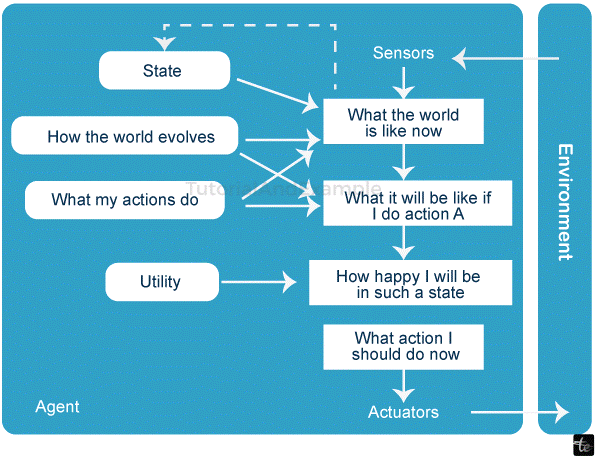
Utility-Based Agents' Characteristics:
The utility function of utility-based agents measures the value or desirability of various outcomes or states. This function gives each potential result a numerical value or utility score, enabling the agent to compare and assess various possibilities.
Utility-based agents perceive their surroundings by using sensors or input devices to gather data. They make use of this perceptual data to evaluate the status of the environment at the moment and predict the possible results of various actions.
Evaluation of the utility of potential actions is a step in the decision-making process used by utility-based agents. They weigh the anticipated benefits of various outcomes and decide on the course of action that will maximize their total utility or satisfaction.
Utility-based agents are capable of navigating circumstances where there are trade-offs between various outcomes. Based on their preferences or priorities, as determined by their utility function, they can give particular outcomes a higher priority.
Utility-Based Agents' Benefits:
- Utility-based agents can modify their preferences or utility functions to adapt to changes in the environment or their aims. They can order various outcomes according to changing conditions or user-defined choices.
- Utility-based agents can make better decisions by taking into account the trade-offs between various outcomes. They choose courses of action that will maximize their total usefulness while taking into account both immediate and long-term effects.
- Utility-based agents can be customized to reflect individual preferences. Making decisions can be personalized by modifying the utility function to reflect the unique tastes or values of the agent or user.
- Utility-based agents have applications in a variety of fields where decision-making includes taking into account the relative worth or desirability of outcomes. Several instances include:
- Utility-based agents can be used to optimize investment choices in financial portfolio management. The agent assesses various investment opportunities based on possible returns, hazards, and the utility function of the investor.
- Utility-based agents are employed in systems for individualized recommendations. The agent analyses user preferences and produces suggestions that maximize utility or enjoyment for the user.
- Utility-based agents can help with issues like distributing scarce resources to various tasks or projects. The agent chooses the most advantageous distribution by taking into account the utility or value associated with each allocation alternative.
The framework provided by utility-based agents allows for decision-making based on utility functions or preferences. These agents choose activities that maximize their total utility while taking into account the desirability or worth of various outcomes. Applications of utility-based agents in the real world include resource allocation, recommendation systems, and financial management. Utility-based agents will remain essential in creating intelligent systems capable of making logical and individualized judgments as AI develops.
5. Learning Agents
Learning agents are capable of enhancing their performance over time by taking experience into account. These agents learn from their encounters with the environment and apply that learning to future judgments.
Adaptive game-playing agents, recommender systems, and autonomous cars are examples of learning agents in the real world.
AI agents that can learn new things and get better with practice are known as learning agents. These agents use learning algorithms and techniques to study their surroundings, gather data, learn from it, and modify their behavior by what they have learned. Learning agents can adapt to shifting conditions, refine their activities, and improve performance over time.
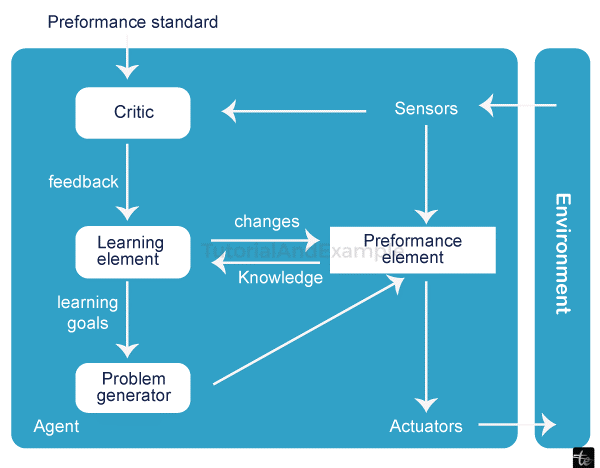
Learning agents have the following traits:
- Learning Component: Learning agents have a learning component that allows them to learn from experience or alter their behavior. Various learning algorithms, including supervised learning, unsupervised learning, reinforcement learning, or a combination of these methods, may be used in this component.
- Perception: Learning agents use input devices or sensors to gather data from their surroundings. They watch and gather information about the status of the environment using this perceptual information.
Learning agents store newly acquired knowledge in an appropriate representation. Depending on the learning technique employed, this representation may take the form of statistical models, neural networks, or symbolic representations.
- Making Decisions: Learning agents make choices depending on the information they have learned. They assess several possibilities using the knowledge they have gained and decide on actions that will improve their performance or help them reach their objectives.
Benefits of Learning agents
Learning agents are adaptable and can change as the environment or their tasks change. They can adapt their behavior and perform better over time by learning from fresh facts.
Generalization: Learning agents can extrapolate information from seen examples to draw conclusions or make predictions about undiscovered or comparable circumstances. They can handle a variety of situations because they can apply learned patterns or models to fresh occurrences.
Autonomy: Without ongoing human supervision or explicit programming, learning agents can work independently while continuously learning and enhancing their performance.
Applications of learning agents in the real world:
There are many different fields and businesses where learning agents are used. Several instances include:
- Autonomous Robotics: To enable autonomous navigation, object recognition, and manipulation in robotics, learning agents are used. Agents get knowledge from sensor data to develop their cognitive and physical skills.
- Natural Language Processing: Learning agents are used for tasks like sentiment analysis, speech recognition, and machine translation in natural language processing. Agents increase language understanding and generation by learning from enormous amounts of linguistic data.
Systems for making personalized suggestions for products, movies, music, and other items are powered by learning agents. Agents learn from user behavior and preferences to make suggestions for products that suit certain preferences.
In conclusion, learning agents are AI agents that can learn new things and get better at what they do. Based on the knowledge they have gained, they adapt their behavior and optimize their activities through learning from data. Due to their adaptability, generalization, and autonomy, learning agents are useful in a variety of fields, including robotics, natural language processing, and recommendation systems. Learning agents will become more and more important in creating intelligent systems that are always learning, adapting, and improving as AI and machine learning techniques grow.
Conclusion:
In artificial intelligence, diverse agent types have different functions and display unique traits. Each form of the agent, from straightforward reflex agents to learning agents, has special capabilities that are appropriate for particular AI applications. Designing intelligent systems that can successfully sense, reason about, and act in their respective contexts benefits from understanding various agent types. The creation of more complex and specialized agents will help artificial intelligence flourish and be used in a variety of industries as it continues to evolve.